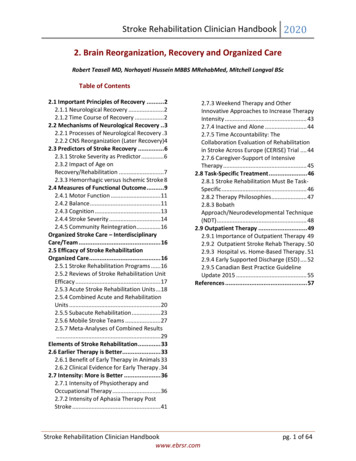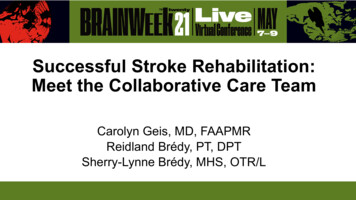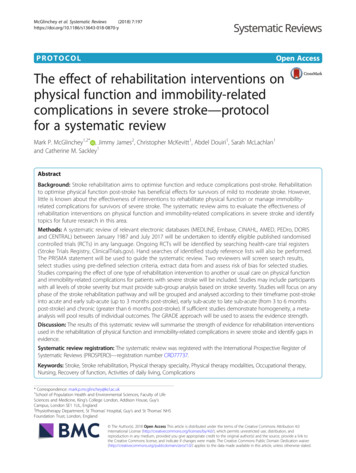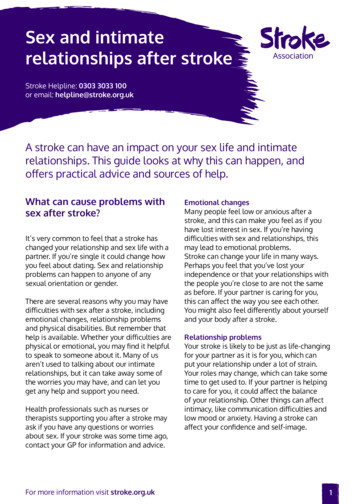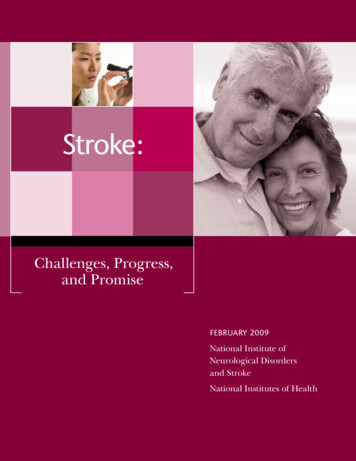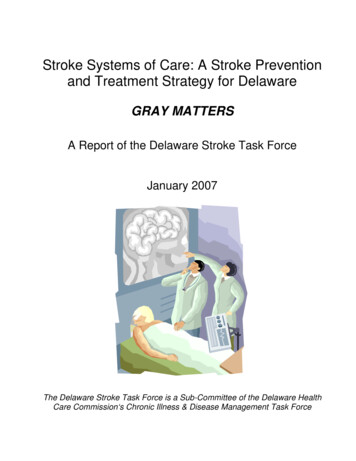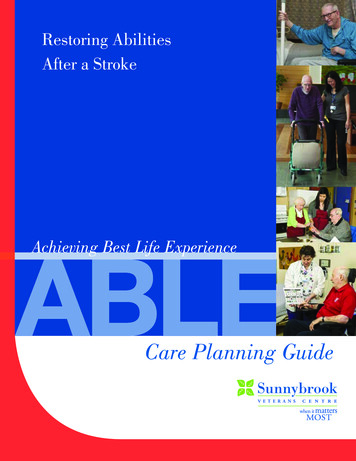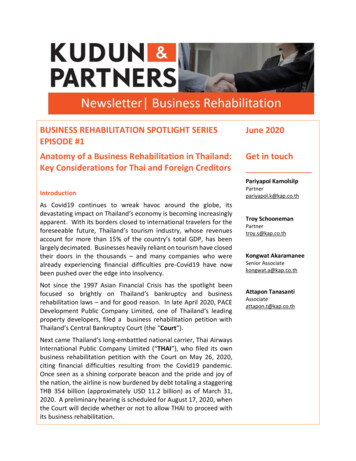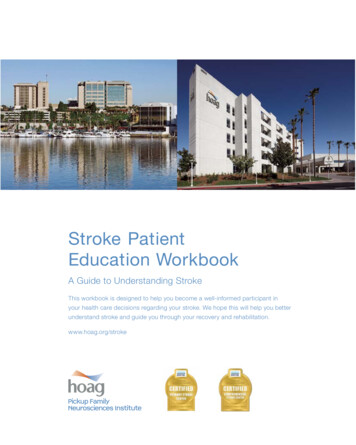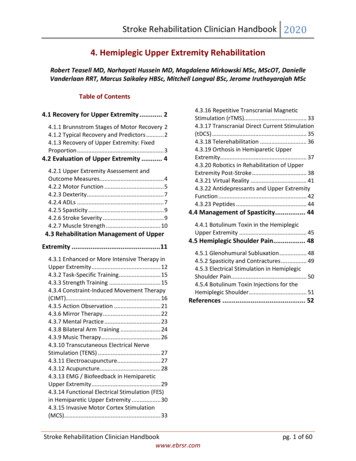
Transcription
Stroke Rehabilitation Clinician Handbook 20204. Hemiplegic Upper Extremity RehabilitationRobert Teasell MD, Norhayati Hussein MD, Magdalena Mirkowski MSc, MScOT, DanielleVanderlaan RRT, Marcus Saikaley HBSc, Mitchell Longval BSc, Jerome Iruthayarajah MScTable of Contents4.1 Recovery for Upper Extremity . 24.1.1 Brunnstrom Stages of Motor Recovery 24.1.2 Typical Recovery and Predictors . 24.1.3 Recovery of Upper Extremity: FixedProportion . 34.2 Evaluation of Upper Extremity . 44.2.1 Upper Extremity Asessement andOutcome Measures. 44.2.2 Motor Function . 54.2.3 Dexterity. 74.2.4 ADLs . 74.2.5 Spasticity . 94.2.6 Stroke Severity . 94.2.7 Muscle Strength . 104.3 Rehabilitation Management of UpperExtremity .114.3.1 Enhanced or More Intensive Therapy inUpper Extremity . 124.3.2 Task-Specific Training . 154.3.3 Strength Training . 154.3.4 Constraint-Induced Movement Therapy(CIMT). 164.3.5 Action Observation . 214.3.6 Mirror Therapy . 224.3.7 Mental Practice . 234.3.8 Bilateral Arm Training . 244.3.9 Music Therapy . 264.3.10 Transcutaneous Electrical NerveStimulation (TENS) . 274.3.11 Electroacupuncture. 274.3.12 Acupuncture. 284.3.13 EMG / Biofeedback in HemipareticUpper Extremity . 294.3.14 Functional Electrical Stimulation (FES)in Hemiparetic Upper Extremity . 304.3.15 Invasive Motor Cortex Stimulation(MCS). 334.3.16 Repetitive Transcranial MagneticStimulation (rTMS). 334.3.17 Transcranial Direct Current Stimulation(tDCS) . 354.3.18 Telerehabilitation . 364.3.19 Orthosis in Hemiparetic UpperExtremity. 374.3.20 Robotics in Rehabilitation of UpperExtremity Post-Stroke . 384.3.21 Virtual Reality . 414.3.22 Antidepressants and Upper ExtremityFunction . 424.3.23 Peptides . 444.4 Management of Spasticity . 444.4.1 Botulinum Toxin in the HemiplegicUpper Extremity . 454.5 Hemiplegic Shoulder Pain. 484.5.1 Glenohumural Subluxation . 484.5.2 Spasticity and Contractures . 494.5.3 Electrical Stimulation in HemiplegicShoulder Pain . 504.5.4 Botulinum Toxin Injections for theHemiplegic Shoulder . 51References . 52Stroke Rehabilitation Clinician Handbookwww.ebrsr.compg. 1 of 60
Stroke Rehabilitation Clinician Handbook 20204.1 Recovery for Upper Extremity4.1.1 Brunnstrom Stages of Motor RecoveryThe Seven Brunnstrom Stages of Motor Recovery (see table below for more details)1. Flaccid paralysis. No reflexes.2. Some spastic tone. No voluntary movement. Synergies elicited through facilitation.3. Spasticity is marked. Synergistic movements may be elicited voluntarily.4. Spasticity decreases. Synergistic movements predominate.5. Spasticity wanes. Can move out of synergies although synergies still present.6. Coordination and movement patterns near normal. Trouble with more rapid complexmovements.7. Normal.Stages of Motor Recovery of the Chedoke McMaster Stroke Impairment Inventory (Gowland et al. 1993)StagesCharacteristicsFlaccid paralysis is present. Phasic stretch reflexes are absent or hypoactive. Active movement1cannot be elicited reflexively with a facilitatory stimulus or volitionally.Spasticity is present and is felt as a resistance to passive movement. No voluntary movement2is present but a facilitatory stimulus will elicit the limb synergies reflexively. These limbsynergies consist of stereotypical flexor and extensor movements.Spasticity is marked. The synergistic movements can be elicited voluntarily but are not3obligatory.Spasticity decreases. Synergy patterns can be reversed if movement takes place in the weaker4synergy first. Movement combining antagonistic synergies can be performed when the primemovers are the strong components of the synergy.Spasticity wanes but is evident with rapid movement and at the extremes of range. Synergypatterns can be revised even if the movement takes place in the strongest synergy first.5Movements that utilize the weak components of both synergies acting as prime movers can beperformed.Coordination and patterns of movement can be near normal. Spasticity as demonstrated by6resistance to passive movement is no longer present. Abnormal patterns of movement withfaulty timing emerge when rapid or complex actions are requested.Normal. A “normal” variety of rapid, age appropriate complex movement patterns are possiblewith normal timing, coordination, strength and endurance. There is no evidence of functional7impairment compared with the normal side. There is a “normal” sensory-perceptual motorsystem.4.1.2 Typical Recovery and PredictorsNakayama et al. (1994) reported that for stroke patients with severe arm paresis with little or no activemovement at the time of hospital admission:o 14% complete motor recovery.o 30% partial recovery.Stroke Rehabilitation Clinician Handbookwww.ebrsr.compg. 2 of 60
Stroke Rehabilitation Clinician Handbook 2020Kwakkel et al. (2003) reported that at 6 months, 11.6% of patients had achieved complete functionalrecovery, while 38% had some dexterity function.Potential predictors of upper extremity recovery include active finger extension and shoulder abduction:1) Active finger extension was found to be a strong predictor of short, medium and long term post-strokerecovery (Smania et al. 2007).2) Minimal shoulder abduction and upper motor control of the paretic limb upon admission torehabilitation had a reasonably good chance of regaining some hand capacity whereas patientswithout proximal arm control had a poor prognosis for regaining hand capacity (Houwink et al. 2013).3) The EPOS study demonstrated that patients with some finger extension and shoulder abduction onDay 2 after stroke onset had a 98% probability of achieving some degree of dexterity at 6 months; thiswas in contrast to only 25% in those who did not show similar voluntary motor control.4) In addition, 60% of patients with finger extension within 72 hours had regained full recovery of upperlimb function according to ARAT score at 6 months. (Nijland et al. 2010).4.1.3 Recovery of Upper Extremity: Fixed ProportionWithin 6 months post stroke upper limb impairment recovers by fixed proportion. Fixed proportion notesthat 70% of each patient’s maximal possible motor improvement occurs regardless of the initialimpairment (i.e. Fugl-Meyer score) but only for those with an intact corticospinal (motor) tract function(Prabhakaran et al. 2008). Irreversible structural damage to the corticospinal tract severely limits recoveryof the upper limb (Stinear et al. 2007; 2012). This fixed proportion of motor recovery of impairmentappears to be unaffected by rehabilitation therapies. 3D kinematics in subacute and chronic strokesurvivors have shown motor recovery associated with rehabilitation is driven more by adaptive orcompensatory learning strategies. Most clinical tests designed to evaluate upper extremity motorrecovery (i.e Action Research Arm Test (see below)) only assess function or a patient’s ability toaccomplish a task.Stroke Rehabilitation Clinician Handbookwww.ebrsr.compg. 3 of 60
Stroke Rehabilitation Clinician Handbook 20204.2 Evaluation of Upper ExtremityThere is a wide range of upper extremity rehabilitation outcomes measures which have been utilized.They can be categorized into broad categories listed below:4.2.1 Upper Extremity Asessement and Outcome MeasuresCategoryMotorFunctionRationaleAssess gross motormovements and a series ofgeneral impairmentmeasures when using theupper extremitiesGlobalStrokeSeverityAssess the severity of strokethrough global assessmentof deficits post stroke.MuscleStrengthAssess muscle power andstrength during movementand tasks.DexterityAssess fine motor andmanual skills through avariety of tasks, particularlywith the use of the hand.Individual Assessment Tools Action Research Arm Test (ARAT) Disabilities of the Arm, Shoulder and Hand(QuickDASH) Fugl-Meyer Assessment (FMA) Finger Oscillation Test (FOT) Jebsen-Taylor Hand Function Test (JTHFT) Manual Function Test (MFT) Motor Club Assessment (MCA) Motor Evaluation Scale for UE in Stroke Patients (MESUE) Motor Status Scale (MSS) Rancho Los Amigos Functional Test for theHemiparetic UE Rivermead Mobility Assessment (RMA) Sodring Motor Evaluation Scale (SMES) Stroke Impairment Assessment Set (SIAS) Stroke Rehabilitation Assessment of Movement(STREAM) Sollerman Hand Function Test (SHFT) Stroke Upper Limb Capacity Scale (SULCS) University of Maryland Arm Questionnaire (UMAQ) Upper Extremity Function Test (UEFT) Wolf Motor Function Test (WMFT) Brunnstrom Recovery Stages (BRS) Modified Rankin Scale (MRS) National Institutes of Health Stroke Scale (NIHSS) Neurological Function Deficit Scale (NFDS) Hand Grip StrengthIsokinetic Peak Torque (IPT)Manual Muscle Strength Test (MMST)Medical Research Council Scale (MRCS)Box and Block Test (BBT)Finger to Nose Test (FNT)Grating Orientation Task (GOT)Grooved Pegboard Test (GPT)Minnesota Manual Dexterity Test (MMDT)Nine Hole Peg Test (9HPT)Stroke Rehabilitation Clinician Handbookwww.ebrsr.compg. 4 of 60
Stroke Rehabilitation Clinician Handbook 2020Range ofMotionAssess ability to freely moveupper extremity at jointsboth passively and actively Purdue Pegboard Test (PPT)Active Range of Motion (AROM)Maximal Elbow Extension Angle During Reach(MEEAR)Passive Range of Motion (PROM)ProprioceptionAssess bodily sensoryawareness and location oflimbs. Joint Position Sense Test (JPST)Kinesthetic Visual Imagery Questionnaire (KVIQ)Revised Nottingham Sensory Assessment (RNSA)Activitiesof DailyLivingAssess performance andlevel of independence invarious everyday tasks. Arm Motor Ability Test (AMAT)Assessment of Motor and Process Skills (AMPS)Barthel Index (BI)ABILHANDCanadian Occupational Performance Measure (COPM)Chedoke Arm and Hand Activity Inventory (CAHAI)Duruoz Hand Index (DHI)Frenchay Arm Test (FAT)Frenchay Activities Index (FAI)Functional Activity Scale (FAS)Functional Independence Measure (FIM)Goal Attainment Scale (GAS)Modified Barthel Index (mBI)Motor Activity Log (MAL)Motor Assessment Scale (MAS)Nottingham Extended ADLs (NEADL)Nottingham Stroke Dressing Assessment (NSDA)Stroke Impact Scale (SIS)STAIS Stroke Questionnaire (SSQ)Upper Limb Self-Efficacy Test (UPSET)Ashworth Scale (AS)Bhakta Finger Flexion Scale (BFFS)Disability Assessment Scale (DAS)Modified Ashworth Scale (mAS)Resistance to Passive Movement Scale (REPAS)Spasm Frequency Scale (SFS)Spasticity4.2.2 Motor FunctionAction Research Arm Test (ARAT)The ARAT is an arm-specific measure of activity limitation that assesses a patient’s ability to handle objectsdiffering in size, weight and shape. The test evaluates 19 tests of arm motor function, both distally andproximally. Each test is given an ordinal score of 0, 1, 2, or 3, with higher values indicating better armmotor status. The total ARAT score is the sum of the 19 tests, and thus the maximum score is 57. Thismeasure has been shown to have good test-retest reliability and internal validity when used to assessmotor function in chronic stroke patients (Ward et al. 2019; Nomikos et al. 2018).Stroke Rehabilitation Clinician Handbookwww.ebrsr.compg. 5 of 60
Stroke Rehabilitation Clinician Handbook 2020Action Research Arm Test (ARAT)QuestionsAnswerWhat does itUpper extremity function and dexterity (Hsueh et al. 2002).measure?What is theThe ARAT consists of 19 items designed to assess four areas of function; grasp, grip,scale?pinch, and gross movement. Each question is scored on an ordinal scale ranging from0 (no movement) to 3 (normal performance of the task).What are the key Scores range from 0 – 57, with lower scores indicating greater levels of impairment.scores?What are itsRelatively short and simple measure of upper limb function.strengths?No formal training is required.Testing can be completed quickly on higher functioning patients.What are itsGood concurrent validity, although other forms of validity have not been evaluatedlimitations?within the stroke population.Significant floor and ceiling effects have been identified (Van der Lee et al. 2002).Unidimensional measure; hence, subset analyses should not be used independentlybut rather summated to provide a single overall score representing upper extremityfunction (Koh et al. 2006).Fugl-Meyer Assessment (FMA)FMA is an impairment measure used to assess locomotor function and control, including balance,sensation, and joint pain in patients poststroke. It consists of 155 items, with each item rated on a threepoint ordinal scale. The maximum motor performance score is 66 points for the upper extremity, 34 pointsfor the lower extremity, 14 points for balance, 24 points for sensation, and 44 points each for passive jointmotion and joint pain, for a maximum of 266 points that can be attained. The measure is shown to havegood reliability and construct validity (Nilsson et al. 2001; Sanford et al. 1993).Fugl-Meyer Assessment for Upper Extremity (FMA-UE)FMA-UE is a measure used to assess motor function of the upper extremity in post-stroke patients. Itconsists of four categories (Shoulder/Elbow/Forearm, Wrist, Hand/Finger, and Coordination) and includes23 different movements which evaluate 33 items. The items are scored on a 3-point rating scale:0 unable to perform, 1 partial ability to perform and 2 near normal ability to perform. The assessmenthas a maximum score of 66, and its reliability and validity have been well demonstrated (Okuyama et al.2018; Villán-Villán et al. 2018).Wolf Motor Function Test (WMFT)The WMFT is a measure that quantifies upper extremity motor ability in stroke survivors. The measureconsists of 17 tasks (e.g. lifting arm up using only shoulder abduction, picking up a pencil, picking up apaperclip). These tasks are then subdivided into 3 areas: functional tasks, measures of strength, andquality of movement. Patients are scored on a 6-point scale (1 cannot complete task, 6 completes taskas well as the unaffected side. This measure has been shown to have good reliability and validity (Wolf etal. 2005; Wolf et al. 2001).Stroke Rehabilitation Clinician Handbookwww.ebrsr.compg. 6 of 60
Stroke Rehabilitation Clinician Handbook 20204.2.3 DexterityBox and Block Test (BBT)BBT is a measure of gross unilateral manual dexterity in stroke survivors. This measure consists of 1functional task. This task involves a patient moving as many wooden blocks as possible from one end of apartitioned box to the other, in a span of 60 seconds. Patients are scored based on the number of blocksthey transfer (the higher the blocks transferred, the better the outcome). The measure has been shownto have good reliability and validity. (Higgins et al. 2005; Platz et al. 2005).Box and Block TestQuestionsWhat does itmeasure?What is thescale?What are the keyscores?What are itsstrengths?What are itslimitations?AnswerPerformance based measure of gross manual dexterity.150 small wooden blocks are placed in one of two equal compartments of apartitioned rectangular box. Respondents are seated and instructed to move asmany blocks as possible, one at a time, from one compartment to the other in 60seconds.The BBT is scored by counting the number of blocks that are carried over thepartition from one compartment to the other during the one-minute trial period.Quick and easy to administer.The simplicity of the performance task and the seated administration position maymake the test more accessible to a wider range of individuals.Established age and gender-stratified norms increase the interpretability to theresults.Results may have utility as a prognostic indicator of physical health.Noisy to administer and could be distracting to other patients.Nine Hole Peg Test (9HPT)The 9HPT is a measure of overall manual dexterity in stroke survivors. The measure consists of 1functional task. Patients are asked to take 9 pegs out of a container and insert them into the pegboard.Once all 9 pegs are inserted they are then taken out of the pegs as quickly as possible and placed back inthe container. Patients are scored on how quickly they can insert and take out the pins, so the faster thetime, the better the outcome. This measure has been shown to have good reliability and concurrentvalidity (da Silva et al. 2017).Purdue Pegboard Test (PPT)The PPT is a measure of precision grip strength and speed in stroke survivors. The measure consists of 1functional task. Patients are asked to place as many pins as they can onto the pegboard in 30 secs, andthen repeat this exercise for their other hand. Patients are scored on the number of pins they can placeonto the pegboard in the given amount of time. This measure has been shown to have good reliabilityand validity (Gonzalez et al. 2017, Wittich & Nadon, 2017).4.2.4 ADLsBarthel Index (BI)Stroke Rehabilitation Clinician Handbookwww.ebrsr.compg. 7 of 60
Stroke Rehabilitation Clinician Handbook 2020The Barthel Index is a measure of how well a stroke survivor can function independently and how wellthey can perform activities of daily living (ADL). The measure consists of a 10-item scale (e.g. feeding,grooming, dressing, bowel control). Each task is then measured on a 3-point functional ability scale/levelof independence scale. This measure has been shown to have good reliability and validity in its full form(Gonzalez et al. 2018; Park et al. 2018).Bimanual Hand Ability (ABILHAND)The ABILHAND is a measure of how well a stroke survivor utilizes their hands to complete various manualtasks. The measure consists of 23 common bimanual activities (e.g. hammering a nail, wrapping gifts,cutting meat, buttoning a shirt, opening mail). Each task is then scored on a 3-point scale (0 impossible,1 difficult, 2 easy) assessing overall ability. This measure has been shown to have good reliability andvalidity in its full form (Ashford et al. 2008; Penta et al. 2001).Canadian Occupational Performance Measure (COPM)The COPM is a measure of how well a stroke survivor engages in self-care, productivity and leisure. Themeasure consists of 25 functional items/tasks (e.g. bathing, ability to work at least part-time, activitiesinvolved in). Each task is then scored on a single 10-point rating scale primarily measuring proficiency ineach of the 3 sub-categories (self-care, productivity and leisure). This measure has been shown to havegood reliability and validity in its full form. (Yang et al. 2017).Chedoke Arm and Hand Activity Inventory (CAHAI)The CAHAI is an upper limb measure that uses a 13-point quantitative scale in order to assess recovery ofthe arm and hand in performing activities of daily living after a stroke. It is a performance test using 13bimanually performed real-life items, designed to encourage bilateral upper limb use. Scores representthe patient’s relative ability to independently perform stabilisation or manipulation in ADL with theimpaired upper limb. The measure is shown to have good test-retest and interrater reliability, as well asgood construct and concurrent validity (Ward et al. 2019; Schuster-Amft et al. 2018; Barreca et al. 2004).Functional Independence Measure (FIM)The FIM is a measure of burden of care and as such is a reverse marker of functional independence, whichis defined as the ability to carry out everyday tasks safely and without assistance. The measure consistsof 6 areas of function (sphincter control, self-care, mobility, locomotion, communication, and socialcognition). The items in these areas consist of: bladder management, grooming, moving in and out of abathtub, walking speed, comprehension, and social interaction. Each task is then scored on a 7-pointLinkert scale (1 total assistance). This measure has been shown to have excellent reliability andconcurrent validity in its full form (Granger et al. 1998, Linacre et al. 1994; Granger et al. 1993).Modified Barthel Index (MBI)The MBI is a measure of how well a stroke survivor can function independently and how well they canperform activities of daily living (ADL). The measure consists of a 10 item scale (e.g. feeding, grooming,dressing, bowel control). Each task is then measured on a 5-point functional ability scale/level ofindependence scale. This measure has been shown to have good reliability and validity in its full form.Note: The only difference between the modified Barthel Index and the original Barthel Index is that themodified Barthel Index has a 5-point rating scale while the original Barthel Index (MacIsaac et al. 2017;Ohura et al. 2017).Motor Activity Log (MAL)Stroke Rehabilitation Clinician Handbookwww.ebrsr.compg. 8 of 60
Stroke Rehabilitation Clinician Handbook 2020The MAL is a patient-reported measure of the use and quality of movement of the impaired arm. Themeasure consists of 30 functional tasks (e.g. handling utensils, buttoning a shirt, combing hair). Each taskis then measured on a 6-point scale (0 complete inability to use affected arm). This measure has beenshown to have good reliability and validity (Chuang et al. 2017).Motor Assessment Scale (MAS)The MAS is a performance-based measure that assesses everyday motor function. The measure consistsof 8 motor-function based tasks (e.g. supine lying, balanced sitting, walking). Each task is then measuredon a 7-point scale (0 suboptimal motor performance, 6 optimal motor performance). This measure hasbeen shown to have good reliability and concurrent validity (Simondson et al. 2003).Stroke Impact Questionnaire (SIS)The SIS is a patient-reported measure of multi-dimensional stroke outcomes. The measure consists of 59functional tasks (e.g. dynamometer, reach and grab, walking, reading out loud, rating emotionalregulation, word recall, number of tasks completed, and shoe tying). These tasks are then divided into 8distinct subscales which include: strength, hand function, mobility, communication, emotion, memory,participation and activities of daily living (ADL). Each task is measured on a 5-point scale (1 an inabilityto complete the task, 5 not difficult at all). The measure has been shown to have good reliability andvalidity (Mulder et al. 2016; Richardson et al. 2016).4.2.5 SpasticityAshworth Scale (AS)The Ashworth Scale is a measure of resistance to passive movement in stroke survivors. The measurecontains 15 functional movements which are done with the guidance of a trained clinician. Thesemovements are evenly divided into 2 sections: upper extremity and lower extremity. Each movement isthen rated on a 5-point scale (0 no increase in muscle tone, 1 barely discernible increase in muscle tone,2 moderate increase in muscle tone 3 profound increase in muscle tone (movement of affected limb isdifficult) 4 complete limb flexion/rigidity (nearly impossible to move affected limb)). This measure hasbeen shown to have good reliability and validity (Merholz et al. 2005; Watkins et al. 2002).Modified Ashworth Scale (mAS)The mAS is a measure of muscle spasticity for stroke survivors. The measure contains 20 functionalmovements which are done with the guidance of a trained clinician. These movements are evenly dividedinto 2 sections: upper extremity and lower extremity. Each movement is then rated on a 6-point scale(0 no increase in muscle tone, 1 barely discernible increase in muscle tone 1 slight increase in muscletone, 2 moderate increase in muscle tone 3 profound increase in muscle tone (movement of affectedlimb is difficult) 4 complete limb flexion/rigidity (nearly impossible to move affected limb)). This measurehas been shown to have good reliability and validity (Mehrholz et al. 2005; Blackburn et al. 2002).4.2.6 Stroke SeverityBrunnstrom Recovery Stages (BRS)BRS is a measure of stroke severity and muscle spasticity in stroke survivors. The measure contains 35functional movements which are done with the guidance of a clinician (e.g. should abduction, shoulderadduction, leg flexion/extension). These movements are evenly divided into 2 sections: upper extremityand lower extremity. Each movement is then rated on a 6-point scale (1 Flaccidity is present, and noStroke Rehabilitation Clinician Handbookwww.ebrsr.compg. 9 of 60
Stroke Rehabilitation Clinician Handbook 2020movements of the limbs can be initiated, 2 Movement occurs haltingly and spasticity begins to develop,3 Movement is almost impossible and spasticity is severe, 4 Movement starts to be regained andspasticity begins to decline, 5 More difficult movement combinations are possible as spasticity declinesfurther. 6 Spasticity disappears, and individual joint movements become possible). This measure hasbeen shown to have good reliability and concurrent validity (Naghdi et al. 2010; Safaz et al. 2009).Modified Rankin Scale (mRS)The Modified Rankin Scale is a measure of functional independence for stroke survivors. The measurecontains 1 item. This item is an interview that lasts approximately 30-45 minutes and is done by a trainedclinician. The clinician asks the patient questions about their overall health, their ease in carrying out ADLs(cooking, eating, dressing) and other factors about their life. At the end of the interview the patient isassessed on a 6-point scale (0 bedridden, needs assistance with basic ADLs, 5 functioning at the samelevel as prior to stroke). This measure has been shown to have good reliability and validity (Quinn et al.2009; Wilson et al. 2002).National Institutes of Health Stroke Scale (NIHSS)The NIHSS is a measure of somatosensory function in stroke survivors during the acute phase of stroke.This measure contains 11 items and 2 of the 11 items are passive range of motion (PROM) assessmentsdelivered by a clinician to the upper and lower extremity of the patient. The other 9 items are visual examsconducted by the clinician (e.g. gaze, facial palsy dysarthria, level of consciousness). Each item is thenscored on a 3-point scale (0 normal, 2 minimal function/awareness). This measure has been shown tohave good reliability and validity (Heldner et al. 2013; Weimar et al. 2004).4.2.7 Muscle StrengthHand Grip Strength (HGS)Hand Grip Strength is a measure of the overall hand grip strength in stroke survivors. The measureconsists of 1 functional task. This task involves a patient squeezing the dynamometer and then receivinga hand grip strength measurement. This action is then repeated 1 additional time and the best of the tworeadings is used as a score. This measure has been shown to have good test/retest reliability and validity(Bertrand et al. 2015).Chedoke-McMaster Stroke Assessment ScaleQuestionsAnswerWhat does itThe Chedoke-McMaster Stroke Assessment Scale (CMSA) is a 2-part assessmentmeasure?consisting of a physical impairment inventory and a disability inventory. Theimpairment inventory is intended to classify patients according to stage of motorrecovery while the disability inventory assesses change in physical function.What is theThe scale’s impairment inventory has 6 dimensions; shoulder pain, postural control,scale?arm movements, hand movements, leg movements, and foot movements. Eachdimension (with the exception of ‘shoulder pain’) is rated on a 7- point scalecorresponding to Brunnstrom’s 7 stages of motor recovery. The disability inventoryconsists of a gross motor index (10 items) and a walking index (5 items). With theexception of a 2-minute walking test (which is scored as either 0 or 2), items are scoredaccording to the same 7-point scale where 1 represents total assistance and 7represents total independence.Stroke Rehabilitation Clinician Handbookwww.ebrsr.compg. 10 of 60
Stroke Rehabilitation Clinician Handbook 2020What are the keyscores?The impairment inventory yields a total score out of 42 while the disability inventoryyields a total score out of 100 (with 70 points from the gross motor index and 30 pointsfrom the walking index).What are itsThe use of Brunnstrom staging and FIM scoring increases the interpretability of thestrengths?CMSA and may facilitate comparisons across groups of stroke patients.The CMSA is relatively comprehensive and has been well studied for reliability andvalidity.What are itsTaking approximately 1 hour to complete, the length and complexity of the CMSA maylimitations?make the scale less useful in clinical practice.As primarily a measure of motor impairment, the CMSA should really beaccompanied by a measure of functional disability such as the BI or the FIM.CMSA is based on the Brunnstrom stages of motor recovery (see above).4.3 Rehabilitation Management of Upper ExtremityEnhancing Stroke RecoveryThere are several ways to enhance motor recovery through rehabilitation:Stimulating the Ipsilateral Brain CortexActivities Repeti
Muscle Strength Assess muscle power and strength during movement and tasks. Hand Grip Strength Isokinetic Peak Torque (IPT) Manual Muscle Strength Test (MMST) Medical Research Council Scale (MRCS) Dexterity Assess fine motor and manual skills through a
